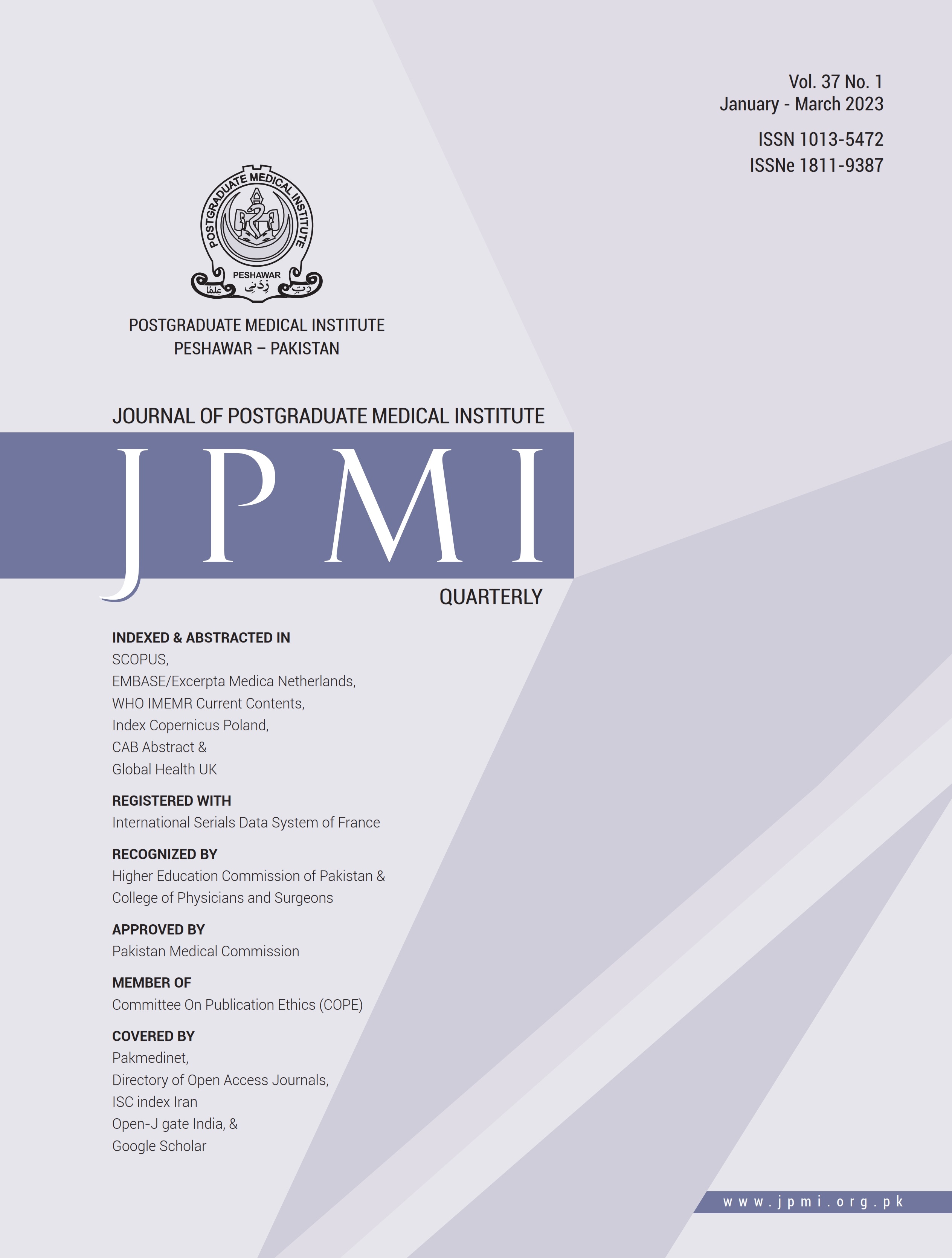VAGINAL CLEANSING BEFORE EMERGENCY CESAREAN SECTION AND POST-OPERATIVE INFECTIOUS MORBIDITY; CLINICAL TRIAL IN A LOW RESOURCE SETTING
Main Article Content
Abstract
Objective: To assess the effectiveness of preoperative vaginal cleansing by looking at the frequency of infectious morbidity after emergency cesarean section.
Methodology: A randomized trial of patients, aged 15-45 years, in labour for > 6 hours, was conducted from May 2019 to December 2019 at the Department of Obstetrics and Gynaecology, Women and children Teaching Hospital, Bannu. A total of 400 patients at term gestation were included and assigned to either the interventional; “Vaginal cleaning” or the control; “No vaginal cleaning” groups, based on whether they received vaginal cleansing only or vaginal cleansing as well as abdominal cleansing or not. The development of infectious morbidity was assessed by following all patients up to six weeks postoperatively.
Results: The age of the women was in the range of 24-38 years. In interventional versus control groups, the frequency of fever was 8 (6%) versus 17 (11%) (p=0.149), and wound infection was 15 (17.5%) versus 16 (8%) (p=0.851) respectively. There was a significant reduction in the frequency of postoperative endometritis, 4 in the interventional group and 18 in the control group (p=0.00). However, on further analysis, in patients with a history of premature rupture of membranes (PROM), there was a significantly lower incidence of endometritis, fever, and postoperative wound infection in the intervention groups (p=0.00).
Conclusions: Using preoperative antiseptic for vaginal cleaning decreases the incidence of postoperative endometritis, more significantly in women with a history of PROM in patients undergoing emergency cesarean section.
Article Details
Work published in JPMI is licensed under a
Creative Commons Attribution-NonCommercial 2.0 Generic License.
Authors are permitted and encouraged to post their work online (e.g., in institutional repositories or on their website) prior to and during the submission process, as it can lead to productive exchanges, as well as earlier and greater citation of published work.
References
Chen I, Opiyo N, Tavender E, Mortazhejri S, Rader T, Petkovic J, et al. Non-clinical interventions for reducing unnecessary caesarean section. Cochrane Database Syst Rev. 2018; 9(9):CD005528. DOI: 10.1002/14651858.CD005528.pub3.
Mascarello KC, Horta BL, Silveira MF. Maternal complications and cesarean section without indication: systematic review and meta-analysis. Rev Saude Publica. 2017;51:105. DOI: 10.11606/ S1518-8787.2017051000389.
Smaill FM, Grivell RM. Antibiotic prophylaxis versus no prophylaxis for preventing infection after cesarean section. Cochrane Database Syst Rev. 2014;10:CD007482. DOI:10.1002/14651858.CD007482. pub3.
Haas DM, Morgan S, Contreras K. Vaginal preparation with antiseptic solution before cesarean section for preventing postoperative infections. Cochrane Database Syst Rev. 2014;12: CD007892. DOI:10.1002/14651858.CD007892. pub5.
Pierson RC, Scott NP, Briscoe KE, Haas DM. A review of post-cesarean infectious morbidity: how to prevent and treat. J Obstet Gynaecol. 2018; 38(5):591-7. DOI:10.1080/01443615. 2017.1394281.
Conroy K, Koenig AF, Yu YH, Courtney A, Lee HJ, Norwitz ER. Infectious morbidity after cesarean delivery: 10 strategies to reduce risk. Reviews in Obstet and Gynecol. 2012;5(2):69-77.
Hadiati DR, Hakimi M, Nurdiati DS, da Silva Lopes K, Ota E. Skin preparation for preventing infection following caesarean section. Cochrane Database Syst Rev. 2018(10). DOI:10.1002/14651858. CD007462.pub4.
Reid VC, Hartmann KE, M MC, Fry EP. Vaginal preparation with povidone-iodine and post-cesarean infectious morbidity: a randomized controlled trial. Obstet Gynecol. 2001;97(1):147-52. DOI:10.1016/s0029-7844(00)01087- 5.
Guzman MA, Prien SD, Blann DW. Post-cesarean-related infection and vaginal preparation with povidone-iodine revisited. Prim Care Update Ob Gyns. 2002;9(6):206-9.
Memon S, Qazi RA, Bibi S, Parveen N. Effect of preoperative vaginal cleansing with an antiseptic solution to reduce post caesarean infectious morbidity. J Pak Med Assoc. 2011;61(12):1179-83.
Ugadu IO, Egede JO, Nwigboji WN, Igwe CP, Nwali AS, Adebayo JA, et al. Pre-operative Vs. Post-operative Vaginal Cleansing with Povidone-iodine and Post-caesarean Infectious Morbidity: A Randomized Controlled Study. J West Afr Coll Surg. 2022;12(4):64-74. DOI:10.4103/jwas.jwas_159_22.
Berríos-Torres SI, Umscheid CA, Bratzler DW, Leas B, Stone EC, Kelz RR, et al. Centers for Disease Control and Prevention Guideline for the Prevention of Surgical Site Infection, 2017. JAMA Surg. 2017;152(8):784-91. DOI:10.1001/jamasurg.2017.0904.
Osborne NG, Wright RC. Effect of preoperative scrub on the bacterial flora of the endocervix and vagina. Obstet Gynecol. 1977;50(2):148-51.
Ogah CO, Anikwe CC, Ajah LO, Ikeotuonye AC, Lawani OL, Okorochukwu BC, et al. Preoperative vaginal cleansing with chlorhexidine solution in preventing post-cesarean section infections in a low resource setting: A randomized controlled trial. Acta Obstet Gynecol Scand. 2021;100(4):694-703. DOI:10.1111/aogs.14060.
Pitt C, Sanchez-Ramos L, Kaunitz AM. Adjunctive intravaginal metronidazole for the prevention of postcesarean endometritis: a randomized controlled trial. Obstet Gynecol. 2001;98(5 Pt 1):745-50. DOI:10.1016/s0029- 7844(01)01517-4..
Kiani SA, Zafar M, Mazhar YS. Vaginal Cleansing Prior to Cesarean Section and Post-Operative Infectious Morbidity. J Soc Obstet Gynaecol Pak. 2018;8(2):95–9.
Haas DM, Morgan S, Contreras K, Enders S. Vaginal preparation with antiseptic solution before cesare-an section for preventing postoperative infections. Cochrane Database Syst Rev. 2018;7(7):CD007892. DOI:10.1002/14651858.CD007892. pub6.
Amstey MS, Jones AP. Preparation of the vagina for surgery. A comparison of povidone-iodine and saline solution. JAMA. 1981;245(8):839-41.
Barat S, Bouzari Z, Ghanbarpour A, Zabihi Z. Impact of preoperative vaginal preparation with povidone-iodine on post-cesarean infection. Caspian J Reprod Med. 2016;2(1):1-7.
Fowler JR, Simon LV. Chorioamnionitis. Treasure Island (FL): Stat Pearls Publishing; 2021.


